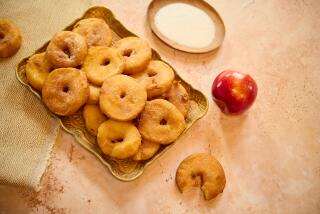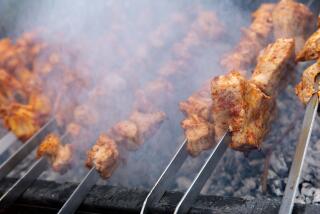Easter Season Means Cooking in a Greek Home : The Central Point of This Holiday Feast Is the Roasted Lamb
- Share via
The tradition of Easter in the Eastern Orthodox churches (May 4) is so closely linked to cooking that the two are inseparable. Or so it seems to Denise Cassis, reared in a Greek family in Spokane, Wash.
In her home, preparations begin on Holy Thursday when eggs are dyed a deep red. On Holy Saturday the Easter bread, Lambropsomo , is baked, and a lamb, just slaughtered at a friend’s farm nearby, is put on a long, wooden spit, ready for roasting whole over red-hot coals.
Celebration continues after worshipers arrive home from a midnight service, carrying Resurrection candles. “You’ll have good luck for the year if you can get all the way home with the candle still lit,” Cassis said.
Preparing for the Feast
After a few hours of sleep, the cooking begins in earnest as the fire is lit and the lamb takes its first, slow circle on the hand-turned spit. The central point of the Easter feast is, of course, the roasted lamb. And, lacking a whole beast, most families now opt for a leg or saddle, cooked with traditional seasonings of garlic, rosemary and lemon. Cassis’ mother adds orzo , small rice-shaped pasta, which she cooks with tomato sauce and the rich juices from the roasting pan.
The rest of the menu combines specific Easter specialties and perennial favorites, all grouped together on the table in happy profusion.
Tiropita cannot be left out--a feta cheese custard baked in buttery layers of filo dough and cut into diamonds. Made year-round, Tiropita is available on street corners in Greece as a mid-morning snack.
More common yet is Greek Salad--appearing in one variation or another every day of the year and, like Tiropita , impossible to omit at Easter. The combination of tomatoes, cucumbers, green peppers, onions, feta cheese and cured black olives, anointed with oregano-laden oil and vinegar, is a refreshing contrast to the richness of the lamb.
Baked Specialties
There are two baked specialties of the Easter season. Lambropsomo is an egg-rich, sweet bread baked with red eggs nested in the plaits, then cut into hearty wedges. Koulourakia are cookies shaped in braids, circles or loops, equally rich with cream and butter and topped with sesame seeds. “Tiresome things (to make),” warns Cassis as she rolls them into shape, “but you’ll understand why they’re worth it when you taste them.”
To accompany a meal of such strong flavors, a strong drink is needed, and the Greeks have it. Retsina wine, with its strong overtones of pine resin, is a perfect companion to a Greek feast, but you may want to offer another choice as some people find it an acquired taste. Other Greek wines and cold beer are acceptable alternatives.
GREEK EASTER FEAST FOR 12
Roast Leg of Lamb With Orzo
Tiropita
Greek Salad
Lambropsomo
Onion-Skin Easter Eggs
Koulourakia Suggested drink: Greek wine such as Retsina, Hymettus or Demestica, or imported beer
Perfect for a festive occasion, most preparation for this menu can be done ahead with only the lamb to roast at the last minute.
Up to one month ahead, bake the Koulourakia and store in an airtight container.
Up to three days ahead, mix the salad dressing and store in a cool place. Dye eggs with onion skins and leave at room temperature.
Up to one day ahead, season the lamb and store, covered, in refrigerator. Assemble and bake the Tiropita, cover and refrigerate. Bake the bread and store in an airtight container. Chill the wine and beer.
About two hours before serving, assemble the salad without dressing and refrigerate. Set the table, adding bowls of dyed eggs.
About 1 3/4 hours before serving, roast the lamb, basting often.
About 30 minutes before serving, remove the lamb from the oven, cover and keep warm. Add tomato and seasonings to roasting pan. Cook orzo .
About 15 minutes before serving, place Tiropita in oven to reheat. Set plates of cookies on table. Add dressing to salad, then place on table.
About 5 minutes before serving, cut Tiropita and place on serving dish.
Just before serving, set bread on board to be cut at table. Carve lamb and mound on platter. Spoon orzo into serving dish. ROAST LEG OF LAMB WITH ORZO
2 (4- to 5-pound) legs of lamb
3 cloves garlic, peeled and slivered
2 lemons
1 bunch rosemary
Salt, pepper
1/2 cup white wine
1 (1-pound) can tomato sauce
6 cups water
1 stick cinnamon
6 whole cloves
2 bay leaves
2 pounds orzo pasta
With point of sharp knife, make deep holes in meat of lamb. Insert garlic slivers. Sprinkle lamb with juice of 1 lemon. Remove 2 tablespoons rosemary leaves from stem. Crush slightly. Rub into surface of meat. Reserve remaining rosemary for decoration. Lamb can be prepared to this point up to 1 day in advance and kept covered in refrigerator.
Place lamb in roasting pan. Season to taste with salt and pepper. Roast, basting often, at 375 degrees until meat is still slightly pink in center, 1 1/4 to 1 1/2 hours or until meat thermometer inserted in center of meat reaches 160 degrees. Halfway through cooking, squeeze remaining lemon juice over meat. Remove lamb to platter. Cover loosely with foil to keep warm.
For orzo, pour off excess fat from meat. Deglaze pan with wine, stirring to dissolve pan juices. Add tomato sauce, water, cinnamon stick, cloves and bay leaves to roasting pan. Bake at 375 degrees 10 minutes. Add orzo, cover and bake 20 to 25 minutes, stirring occasionally or until orzo is tender. Taste and adjust seasonings. Remove cinnamon stick, cloves and bay leaves before serving.
To serve, carve lamb and pile orzo in separate bowl or spoon around edge of platter, piling lamb in center. Decorate lamb with remaining rosemary sprigs. Makes 12 servings. TIROPITA
6 eggs
1/2 cup milk
1 pound feta cheese, crumbled
1 pound filo dough
1/2 pound butter, melted
Beat eggs and milk together. Stir in feta cheese.
Place filo dough on work surface, covering with damp towel to prevent drying. Butter 12x9-inch baking pan. Place 1 sheet filo in bottom. Brush with melted butter. (Filo sheets may go up sides of pan if too large.) Repeat 15 times.
Pour cheese mixture onto filo sheets. Cover with remaining filo, brushing each layer with melted butter. With sharp knife, score filo lengthwise into 3-inch rows, cutting through top layer.
Bake at 350 degrees 50 to 60 minutes or until top is golden. Remove from oven. Let cool slightly. Cut through score marks to bottom layer of filo, then slice diagonally in 2-inch widths to form diamond-shape pieces. Tiropita can be baked up to 1 day ahead and kept covered in refrigerator.
Serve Tiropita warm. To reheat, place, uncovered, in 375-degree oven until very warm, about 15 minutes. Makes 12 servings. GREEK SALAD
1/2 cup red wine vinegar
1 1/2 cups olive oil
1 teaspoon salt
1 tablespoon dried oregano
6 tomatoes, sliced
2 sweet white onions, sliced
2 cucumbers, peeled and sliced
2 green peppers, cored and cut into rings
1 pound feta cheese, sliced
1/2 pound Kalamata olives
Place vinegar, oil, salt and oregano in jar with tight-fitting lid. Shake until well mixed. Dressing can be prepared up to 3 days ahead. Store at room temperature.
Overlap tomatoes, onions and cucumbers alternately, arranging in concentric rings on platter. Top with green peppers, feta cheese slices and olives. Salad can be prepared up to 3 hours ahead and kept covered in refrigerator.
Just before serving, shake dressing well to re-emulsify. Pour over salad as desired. Makes 12 servings.
Note: Kalamata olives are available in Italian, Greek and some specialty groceries. Greek Salad comes in many combinations, depending on what’s fresh from the garden. Sometimes it can be as simple as tomatoes and onions. LAMBROPSOMO
2 packages active dry yeast or 2 cakes compressed yeast
1/2 cup warm water
1 cup milk
1/2 cup butter
7 cups flour, more if needed
1 teaspoon salt
3/4 cup sugar
5 eggs
2 teaspoons crushed anise
5 color-dyed hard-cooked eggs
Sprinkle yeast over water and let stand until dissolved, about 5 minutes. Scald milk in 1-quart saucepan. Set aside. Melt butter in small saucepan. Cool and set aside.
Sift flour, 1/2 teaspoon salt and sugar onto pastry board. Make well in center. Beat 4 eggs. Pour beaten eggs, anise and yeast mixture into well. Work liquid ingredients until mixed, then gradually draw in flour, working until all is incorporated. Press dough into ball. Knead on floured board until smooth and elastic, 8 to 10 minutes.
Lightly grease large mixing bowl. Place dough in bowl, rotating dough until top is oiled. Cover with wet cloth. Let rise in draft-free place until doubled in bulk, 1 1/2 to 2 hours.
Knead dough lightly. Transfer to floured pastry board. Divide into 3 equal portions. Roll each section into rope about 2 inches thick and 20 inches long. Braid together. Bring ends together. Pinch to link ends into round.
Set on lightly greased baking sheet. Press dyed eggs firmly into hollows in plaits, setting 1 in center and rest around to form cross. Cover. Let rise again until doubled in bulk.
Beat remaining egg and 1/2 teaspoon salt together and brush dough with mixture. Bake at 425 degrees 10 minutes. Reduce heat to 350 degrees and bake until bread sounds hollow when tapped on bottom and crust is evenly browned, 50 to 60 minutes longer. (If bread browns too fast, cover with foil.)
To serve, cut in wedges, cutting through dyed eggs. Bread is best eaten on day it is baked, but can be stored 1 day in airtight container. Makes 12 servings. ONION-SKIN EASTER EGGS
6 quarts water
1/2 cup vinegar
Skins from 24 red onions
12 eggs in shells
1 tablespoon oil
Bring water and vinegar to boil in large kettle. Add onion skins. Simmer 30 minutes. Let cool slightly.
Add eggs to mixture. Bring to boil. Simmer until eggs are rich red-brown, about 20 minutes. Remove eggs. Cool in cold water. When cold, rub each with oil. Makes 12 dyed eggs.
Note: Eggs can be kept up to 3 days at room temperature. Onion skin water can be reused to dye more eggs, if needed. Greek Easter eggs have always been as brilliant red as possible. Before days of commercial dyes, eggs were dyed with quantity of onion skins. KOULOURAKIA
3 3/4 cups flour
2 teaspoons baking powder
Salt
1/4 teaspoon ground cinnamon
Dash ground nutmeg
1 teaspoon vanilla
1/2 cup whipping cream
1 cup butter
1 cup sugar
2 eggs
2 to 3 tablespoons sesame seeds
Sift together flour, baking powder, 1/4 teaspoon salt, cinnamon and nutmeg. Stir vanilla into cream.
Cream butter and sugar until light and creamy. Add 1 egg and beat until smooth. Add flour and cream alternately in 3 batches, mixing well after each addition. Lightly butter baking sheet.
To shape braids, roll 3 (4-inch) ropes about 1/2 inch thick on floured board. Braid. For loops, roll 6-inch ropes about 1/2 inch thick. Fold in half. Twist gently 3 times. For circles, roll 4-inch ropes 1 inch thick. Pinch ends together.
Arrange cookies on baking sheet. Combine remaining egg with dash salt and brush over cookies. Sprinkle with sesame seeds. Bake at 350 degrees until light golden and just firm, 15 to 20 minutes. (Cookies do not expand so they can be set close together on baking sheet.) Makes 3 to 4 dozen, depending on shapes used.
Note: Cookies are best made at least 1 week ahead to allow time for flavors to blend. Cookies should be stored in airtight container, up to 1 month, if desired.


